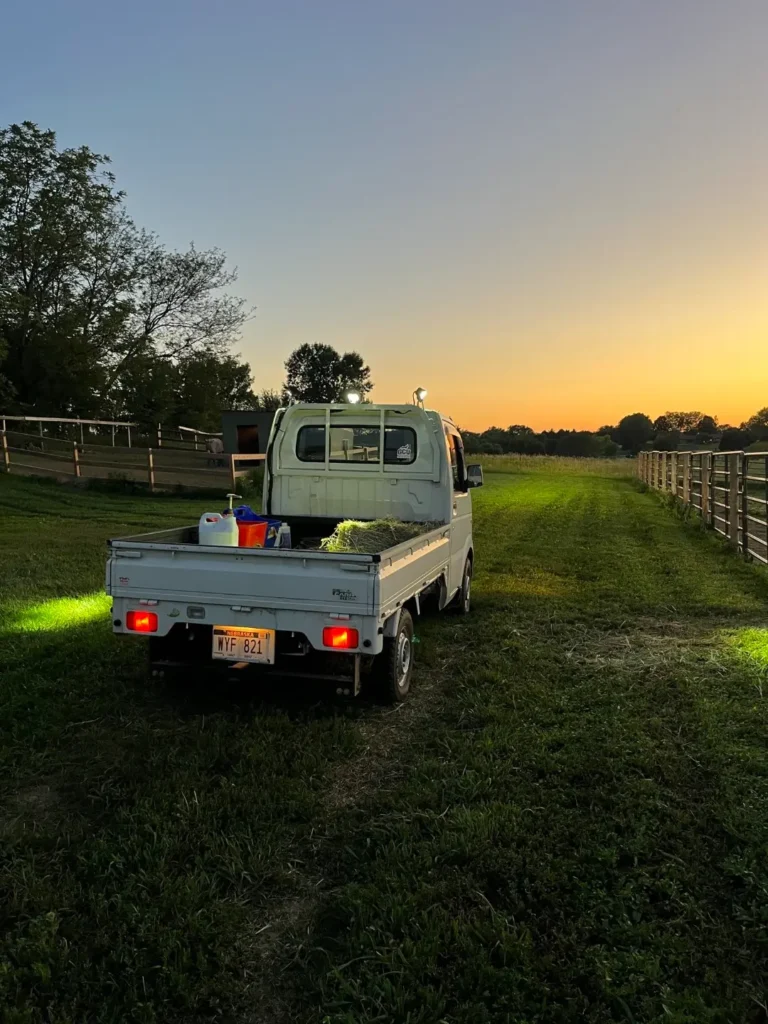Got a versatile Suzuki Carry and thinking about an engine swap to boost performance or breathe new life into your trusty old pal? The engine swap process might seem intimidating, with a bunch of choices and technical aspects you’ll need to tackle. But don’t worry, we’re here to simplify it all for you in this comprehensive guide. We’ll walk you through everything you need to know about swapping a Suzuki Carry’s engine. From getting ready for the task, picking the right engine, to the nitty-gritty of the swap process, and even the common blunders and how to dodge them. By reading this article, you’re arming yourself with the know-how to successfully pull off this intricate task. So, strap in as we explore the ins and outs of a Suzuki Carry’s engine swap.
Introduction to Suzuki Carry Engine Swap
The Suzuki Carry, a compact pickup truck you might know for its versatility and reliability, has been rolling off the production line since 1961. The engine in this vehicle can change depending on the model and year, with some models sporting a 1.3-liter gasoline engine, while others have a 1.5-liter diesel engine. The horsepower of the Suzuki Carry’s engine can also vary, typically cranking out around 60 to 90 horsepower.
The Concept of Engine Swap
Engine swapping is when you replace a car’s original engine with another. This is often done to boost performance or to get an older car back on the road when its engine has given up the ghost. There are two types of engine swaps: like-for-like exchange and non-factory specific swap. The first involves replacing the engine with an identical one, while the second involves installing an engine that wasn’t originally designed for the vehicle.
Why You Might Consider an Engine Swap for Suzuki Carry
You might consider engine swaps for the Suzuki Carry for a few reasons. One of the main ones is to enhance performance, as a bigger capacity engine brings more power and torque. This can be particularly beneficial if you’re using the Suzuki Carry for heavy-duty tasks or if you just want a more powerful driving experience.
Another reason to think about an engine swap is to breathe new life into an older model. Replacing the original engine with a newer, more modern one can give the vehicle a second wind and improve its reliability. However, it’s worth noting that swapping the engine in a Suzuki Carry can be a complex process and isn’t recommended for those without experience. It requires knowledge of automotive mechanics and may involve modifications to the vehicle’s wiring, exhaust system, and other components.
Popular Engine Choices for Swapping
When it comes to swapping the engine in a Suzuki Carry, there are a few popular choices. Some users have thought about swapping in a Suzuki Swift engine, specifically the 1.0 or 1.3 liter turbocharged engine. Another user suggested using the engine from an Arctic Cat snowmobile, a 600cc turbocharged engine with 110 horsepower. However, the choice of engine will largely depend on the performance and power output you’re after.
Potential Issues and Challenges of Engine Swapping
While engine swapping can provide numerous benefits, it’s not without its challenges. The cost of an engine swap can vary depending on factors like the type of engine being swapped, the labor involved, and any additional modifications needed. On average, the cost can range from $2,000 to $5,000 or more.
Moreover, while it’s possible to just swap the engine in a Suzuki Carry, it’s important to ensure that the new engine is compatible with the vehicle’s transmission, suspension, and other components. This may require additional modifications and adjustments to ensure proper fitment and functionality.
The reliability of an engine swap in a Suzuki Carry can depend on various factors, including the quality of the engine being swapped and the expertise of the person performing the swap. It’s important to choose a reputable mechanic and use high-quality parts to ensure the reliability of the engine swap.
Lastly, the fuel efficiency of the Suzuki Carry can vary depending on factors like driving conditions and the specific model and year. On average, the Suzuki Carry can achieve around 10 to 15 liters per 100 kilometers, or approximately 23 to 35 miles per gallon. However, these figures may vary and should be used as a general estimate.
Initial Preparations for an Engine Swap
Before embarking on the engine replacement journey for your Suzuki Carry, it’s crucial to follow several preparatory steps to ensure a successful outcome.
Assessing the Condition of your Suzuki Carry
Initially, a thorough examination of your vehicle’s current state is necessary. Despite its reputation for durability and cost-effectiveness, the Suzuki Carry, like any other vehicle, can develop issues over time. Potential problems could include fuel injector and pump malfunctions, transmission glitches, and hydraulic system complications. Addressing these issues prior to an engine swap is essential to avoid compromising the performance of your vehicle.
Selecting the Right Engine For Swap
The subsequent step involves choosing an appropriate engine for the swap. The Suzuki Carry’s engine history is diverse, with sizes ranging from a 359 cc two-cylinder to a 660cc three-cylinder. When selecting an engine, it’s important to consider the weight and horsepower of the replacement to ensure it won’t adversely affect your vehicle’s performance.
Gathering Essential Tools and Equipment
Once you’ve identified the suitable engine, the next step is to assemble the required tools and equipment for the swap. This includes basic tools as well as any bespoke parts that may be necessary to accommodate the new engine in your Suzuki Carry. Remember, the financial implications of engine swaps can be significant, encompassing the cost of the engine, labor, and any additional parts or modifications required.
Creating a Safe Working Environment
Lastly, prior to commencing the engine swap, it’s crucial to establish a safe working environment. This involves ensuring sufficient workspace, adequate lighting, and the availability of all necessary safety equipment. Given the complexity and potential risks associated with engine swaps, it’s vital to adhere to all safety measures.
Detailed Process of Suzuki Carry Engine Swap
The process of replacing the engine in your Suzuki Carry requires meticulous planning and execution. The vehicle typically houses a F10A engine, a 1.0-liter, four-cylinder engine. However, you might want to consider an EFI engine, such as the K10A engine, to enhance power, efficiency, and fuel economy.
Engine Removal Steps
The initial phase of the engine swap process involves removing the existing engine. This requires lifting the body of the Suzuki Carry, detaching the gearbox, disconnecting the wiring, radiator hoses, and fuel lines, removing the cross member and engine mounts, and finally lowering the engine. As the vehicle ages, you might need to consider replacing components like the spark plugs, spark plug wire set, and even the front wheel bearings and wheel seals.
Checking Replacement Engine
Before installing the new engine, it’s crucial to verify its condition and compatibility with the Suzuki Carry. This includes ensuring that the new engine fits and isn’t too heavy for the vehicle. If you’re considering a K10A engine, you might need to adjust the crossmember, engine mounts, and yoke to the propeller shaft. It’s also advisable to use the entire engine, including the loom and computer, from the donor vehicle when swapping engines.
Tips for Engine Installation
During the installation of the new engine, proper alignment of the engine and transmission is crucial. You should connect all necessary components, and double-check all connections for tightness. Other parts that might need to be replaced include the fuel pump, radiator fan, and radiator hoses. After a successful engine conversion, you might need to replace the fan-driven belt with an electrical fan. The wiring for the front panel information, such as the fuel and coolant meter, might also need to be rewired and connected to the ECU of the K10A engine.
Ensuring Proper Connection of Engine Components
Once you’ve installed the new engine, it’s important to verify that all components are properly connected. This includes the timing belt and tensioner, which should be replaced along with the water pump to prevent engine damage. Common tune-up items for the Suzuki Carry include the distributor cap, distributor rotor, fuel, oil, and air filters.
The cost of a basic engine swap can vary depending on the specific engine and any additional modifications required. It’s advisable to consult with a mechanic or specialist for an accurate estimate. The reliability of the engine swap will depend on the quality of the installation and the condition of the donor engine.
The Suzuki Carry with the F10A engine has a fuel consumption rate of approximately 8-10 liters per 100 kilometers. The fuel consumption may vary with the engine swap. It’s important to do thorough research and consult with experts or mechanics before attempting an engine swap to ensure compatibility and proper installation.
Post Installation Checks and Precautions
Once the engine swap in your Suzuki Carry is complete, there are several post-installation checks and precautions to consider. These steps are crucial to ensuring the durability and dependability of your new engine.
Inspecting for Leaks and Misalignments
The first task post-installation is to inspect for any leaks or misalignments. This involves examining the engine oil, coolant, and fuel systems for any signs of leakage. Additionally, the alignment of the engine and its components should be checked. Misalignments can lead to premature wear and tear, impacting the overall performance and lifespan of your engine.
Performing the Initial Start-up
The first start-up of your new engine is a pivotal step. You should initiate the engine and let it idle for a few minutes. This allows the oil to circulate and lubricate all the engine components. During this time, monitor the engine temperature and oil pressure. Any abnormal readings could indicate a problem that requires immediate attention.
Break-in Period Recommendations
Similar to a new car, a newly installed engine also has a break-in period. This period allows the engine components to settle in and operate together smoothly. During the break-in period, try to avoid aggressive driving and high RPMs. This helps to ensure the durability and dependability of your new engine.
Maintenance Tips Post Engine Swap
Maintaining your new engine is just as crucial as the installation process. Regular oil changes, checking the coolant level, and inspecting the engine belts are some of the basic maintenance tasks you’ll need to perform regularly. It’s also advisable to monitor the fuel efficiency of your engine. If you notice a significant drop in fuel efficiency, it could indicate a problem that needs to be addressed.
Taking care of your Suzuki Carry’s engine is key to its dependability. With proper care and maintenance, your new engine can serve you reliably for many years to come.
Common Mistakes in Suzuki Carry Engine Swap and How to Avoid Them
Swapping the engine in a Suzuki Carry isn’t a straightforward task. There’s a lot to consider, and errors can be expensive. Let’s examine some frequent blunders and how you can prevent them.
Incorrect Engine Choice
The Suzuki Carry provides a range of engine options, including the F6A and K6A engines, both 660cc three-cylinder engines. The horsepower can vary from 40 to 64, depending on the engine model and any modifications. For instance, the Suzuki Carry DA63T, introduced in 2002 and ran until 2013, comes with a 658cc K6A engine producing 49 horsepower.
Selecting an unsuitable engine for your Suzuki Carry could lead to a myriad of issues, including subpar performance and decreased fuel efficiency. Understanding the specifications of your vehicle and the engine you’re considering for the swap is crucial. Consulting with a professional mechanic or engine swap specialist can assist you in making an informed decision.
Overlooking Engine Compatibility
While it’s possible to swap just the engine in a Suzuki Carry, compatibility is a critical factor. Ignoring engine compatibility could result in improper fitment and functionality. The new engine must align with your vehicle’s specifications and require minimal modifications for proper installation.
The cost of an engine swap can fluctuate based on factors like the cost of the new engine, modifications, and labor. Therefore, it’s important to consider compatibility to avoid unnecessary expenses and complications.
Negligent Post-Installation Checks
The success of an engine swap in a Suzuki Carry hinges on the quality of the new engine, the skill of the installer, and vehicle maintenance. Conducting thorough checks after the installation to ensure everything is functioning correctly is essential. Neglecting post-installation checks could lead to issues down the line, affecting the reliability and performance of your vehicle.
Choosing a reputable engine supplier and skilled mechanic can significantly enhance the reliability of your Suzuki Carry with a swapped engine. Regular maintenance is also key to ensuring the longevity and performance of your vehicle.
Skipping Essential Step in Engine Break-in period
The engine break-in period is a crucial phase that many vehicle owners overlook. This period allows the engine components to settle and work together effectively. If you skip this step, you could face premature engine wear and tear, affecting the performance and lifespan of your engine.
Proper engine break-in can also contribute to optimal fuel efficiency.
Suzuki Carry Engine Swap: A Considered Decision
Swapping the engine in your Suzuki Carry isn’t a decision to be taken lightly. It’s a process that needs careful planning, a solid grasp of automotive mechanics, the right engine choice, and a trustworthy mechanic. The costs can fluctuate based on a variety of factors, from the specific engine you choose to the amount of labor involved.
Don’t overlook the importance of post-installation checks and the engine break-in period. Keeping up with vehicle maintenance after the swap is key to ensuring its ongoing reliability. When you take all these factors into account, an engine swap can breathe new life into your Suzuki Carry, boosting power, efficiency, and giving you the satisfaction of a job well done.












1 comment
nico
Interesting but it will be more interesting if you could fine some people that I’ve already done the change and who would be able to help us !